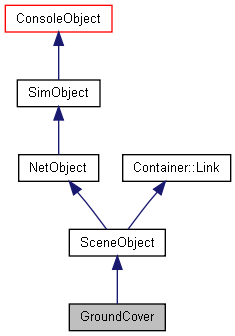GroundCover Class Reference#include <groundCover.h>
Inheritance diagram for GroundCover: 
Member Typedef Documentation
Reimplemented from SceneObject.
Member Enumeration Documentation
Constructor & Destructor Documentation
Member Function Documentation
Register global constant variables and do other one-time initialization tasks in a subclass of ConsoleObject.
Reimplemented from ConsoleObject.
Register dynamic fields in a subclass of ConsoleObject.
Reimplemented from SceneObject.
Called after any property of the object is changed in the world editor.
Reimplemented from SceneObject.
Instructs this object to pack its state for transfer over the network.
Reimplemented from NetObject.
Called when the SceneGraph is ready for the registration of RenderImages.
Reimplemented from SceneObject.
Sets the global ground cover LOD scalar which controls the percentage of the maximum designed cover to put down. It scales both rendering cost and placement CPU performance. Returns the actual value set.
Returns the current quality scale... see above.
Called when GroundCover parameters are changed and things need to be reinitialized to continue.
Updates the cover grid by removing cells that have fallen outside of mRadius and adding new ones that have come into view.
Clears the cell grid, moves all the allocated cells to the free list, and deletes excess free cells.
Clears the cell grid and deletes all the free cells.
Returns a cell to the free list.
Generates a new cell using the recycle list when possible.
Used to gather a list of TerrainBlocks from findObjects.
Friends And Related Function Documentation
Member Data Documentation
This RNG seed is saved and sent to clients for generating the same cover.
This is the outer generation radius from the current camera position.
This is less than or equal to mRadius and defines when fading of cover elements begins.
This is the distance at which DTS elements are completely culled out.
This is used to scale the various culling radii when rendering a reflection. .. typically for water.
This is the number of cells per axis in the grid.
This is the allocator for GridCell chunks.
This is the grid of active cells.
This is a scratch grid used while updating the cell grid.
This is the index to the first grid cell.
The maximum amount of cover elements to include in the grid at any one time. The actual amount may be less than this based on randomization.
Used to detect changes in cell placement count from the global quality scale so we can regen the cells.
Used for culling cells to update and render.
The shader used to render the ground cover billboards.
Debug parameter for displaying the grid cells.
Debug parameter for turning off billboard rendering.
Debug parameter for turning off shape rendering.
Debug parameter for locking the culling frustum which will freeze the cover generation.
Stat for number of rendered cells.
Stat for number of rendered billboards.
Stat for number of rendered billboard batches.
Stat for number of rendered shapes.
Used to detect when to reset the stats.
The global ground cover LOD scalar which controls the percentage of the maximum amount of cover to put down. It scales both rendering cost and placement CPU performance.
The name of the texture atlas of the cover billboards.
The texture atlas of the cover billboards.
This is the maximum amout of degrees the billboard will tilt down to match the camera.
The probability of one cover type verses another.
The minimum random size for each cover type.
The maximum random size of this cover type.
An exponent used to bias between the minimum and maximum random sizes.
The wind effect scale.
The maximum slope angle in degrees for placement.
The minimum world space elevation for placement.
The maximum world space elevation for placement.
The integer terrain data layer or -1 to not test placement against one.
Inverts the data layer test making the layer an exclusion mask.
The minimum amount of elements in a clump.
The maximum amount of elements in a clump.
An exponent used to bias between the minimum and maximum clump counts for a particular clump.
The maximum clump radius.
The billboard atlas texture uvs.
This is a cached array of billboard aspect scales used to avoid some calculations when generating cells.
The cover shape filenames.
The cover shape instances.
This is the same as mProbability, but normalized for use during the cover placement process.
A shared primitive buffer setup for drawing the maximum amount of billboards you could possibly have in a single cell.
The length in meters between peaks in the wind gust.
Controls how often the wind gust peaks per second.
The maximum distance in meters that the peak wind gust will displace an element.
The direction of the wind.
Controls the overall rapidity of the wind turbulence.
The maximum distance in meters that the turbulence can displace a ground cover element.
|
||||||||||||||||||||||||||||||||||||||||||||||||||||||||||||||||||||||||||||||||||||||||||||||||||||||||||||||||||||||||||||||||||||||||||||||||||||||||||||||||||||||||||||||||||||||||||||||||||||||||||||||||||||||||||||||||||||||||||||||||||||||||||||||||||||||||||||||||||||||||||||||||||||||||||||||||||||||||||||||||||||||||||||||||||||||||||||||||||||||||||||||||||||||||||||||||||||||||||||||||||||||||||||||||||||||||||||||||||||||||||||||||||||||||||||||||||||||||||||||||||||||||||||||||||||||||||||||||||||||||||||||||||||||||||||||||||||||||||||||||||||||||||||||||||||||||||||||||||||||||||||||||||||||||||||||||||||||||||||||||||||||||||